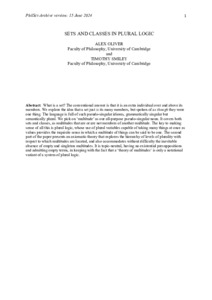Oliver, Alex and Smiley, Timothy
(2024)
Sets and classes in plural logic.
[Preprint]
![[img]](https://philsci-archive.pitt.edu/23573/1.hassmallThumbnailVersion/Sets%20and%20Classes%20in%20Plural%20Logic%20PhilSci-Archive%20version%2015%20June%202024.pdf)  Preview |
|
Text
Sets and Classes in Plural Logic PhilSci-Archive version 15 June 2024.pdf
Download (1MB)
| Preview
|
Abstract
What is a set? The conventional answer is that it is an extra individual over and above its members. We explore the idea that a set just is its many members, but spoken of as though they were one thing. The language is full of such pseudo-singular idioms, grammatically singular but semantically plural. We pick on ‘multitude’ as our all-purpose pseudo-singular noun. It covers both sets and classes, as multitudes that are or are not members of another multitude. The key to making sense of all this is plural logic, whose use of plural variables capable of taking many things at once as values provides the requisite sense in which a multitude of things can be said to be one. The second part of the paper presents an axiomatic theory that explores the hierarchy of levels of plurality with respect to which multitudes are located, and also accommodates without difficulty the inevitable absence of empty and singleton multitudes. It is topic-neutral, having no existential presuppositions and admitting empty terms, in keeping with the fact that a ‘theory of multitudes’ is only a notational variant of a system of plural logic.
Monthly Views for the past 3 years
Monthly Downloads for the past 3 years
Plum Analytics
Actions (login required)
 |
View Item |



